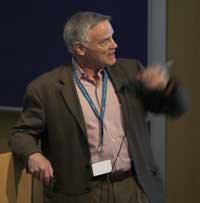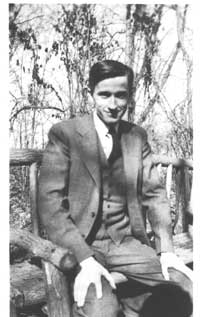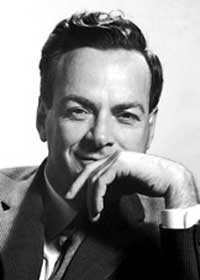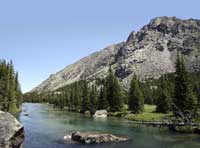New approaches to old systems: interview with Leroy Hood Understand article
Leroy Hood talks to Marlene Rau, Anna-Lynn Wegener and Sonia Furtado about his long-standing commitment to innovative science teaching, and how he came to be known as the father of systems biology.

biology
Image courtesy of EMBL Photolab
“Students hate being taught didactically, they hate listening to lectures, they hate the presentation of facts. What students, especially the younger ones, like is getting involved, doing things with their hands.”
With this in mind, Leroy Hood, a man who decides to change the world and then goes out and does it, set out to change the way science is taught in all Seattle schools: “Hands-on, inquiry-based science is what we wanted to implement when we moved here in 1992w1. Our first effort was to convert all 72 elementary schools in Seattle – all 23 000 students and 1 100 teachers – to this approach. The focus was, over a five-year period, a series of workshops that gave teachers 100 to 150 hours’ instruction – both methods and content. You really need both: if it’s all gee-whiz and no content, it isn’t any good. We probably reached between 90 and 95% of the teachers and really transformed the way the educational system thinks about teaching. We then followed that up with a grant for middle schools to do the same thing, and we would have had a grant for high schools, except we were awarded that grant just when Bush became president, and he cancelled all the education funds, so we had to do high schools on a more piecemeal basis….”
These workshops provided teachers with kits they could use in the classroom, and with the knowledge to back them up: “One kit involved figuring out what Archimedes’ principle is all about, having the students build boats with different shapes and trying to figure out the relationship between boat shape and water displacement. But even more important was for the teachers to really understand the science: specific gravity of water, displacement, buoyant forces… Most teachers in the USA have very little grounding in science; in elementary school only 3–4% of the teachers have had any science training at all. And since at that level only one teacher handles each class, many students essentially never had any science teaching before we started this counselling.”
Another strength of the project was that it focused on teachers as part of the scientific community, instead of treating them as outsiders: “They absolutely loved that we treated them as colleagues, as an important part of the scientific community, with two roles. One is to catalyse the interest in science in those students who have the inclination and capacity to do it, but the other, even more important, role is educating tomorrow’s citizens about science, so that they can go into society with a much more factual and information-based view of all these things, good and bad, and can make judgments. This really rejuvenated the teachers from the point of view of their interest in science as part of a larger community and this was reflected in how they taught science to the kids.”
A big part of the project’s success came from the strategic partnerships that were set up: “To make this happen, we really had to raise a lot of money. So we created partnerships with Boeing, Microsoft and a lot of other businesses, and used those as leverage to raise substantial resources for the schools. That was really an important part of creating a model that had demonstrable power. And of course the ultimate objective in all of these programmes is sustainability: we’d like to persuade the school systems, once they see the power of what’s been done, to start transferring funds to this approach. At some of the schools in Seattle, this has already started happening.”
Hood and his team are now reaching out across the state, attracting top-notch teachers and educational administrators to workshops on their approach, so that those teachers can then go out and nucleate such changes in their own communities. “We have recruited six really terrific science teachers who do this full-time now. These are people who can do the science, and who really know how to teach. This is important, because people like me are really great with the science part of things, but we’ve never had to deal with the reality of a first grader or a high-school freshman.
“For instance, for one of the high schools, we built a couple of modules to teach systems biology. Systems biology is all about understanding networks, so one of the first things we do is have the teacher draw a network of all the kids who have cell phones in the class, and of the numbers they can automatically dial. And then the students sit down and they understand, ‘oh, it’s the connections’, and they understand what would happen if you broke those connections. It’s a very simple way of realising that biology operates on information in exactly the same way, and they understand it right away.”
So what exactly is systems biology?

/ iStockphoto
“To me, systems biology is an attempt to look at biology from a holistic rather than an atomistic point of view. The only way you can understand all the marvellous emerging properties of a system is by defining all its components and their interactions, and then looking at how they change dynamically with regard to stimuli that activate the whole system. You create a model that might explain the system and then formulate hypotheses and test them with perturbations to the system, and see if the data you get back really fits your model. It never does in the early stages, so then you just do this in a cyclic way. You never achieve ultimate understanding, but you get models that are more and more predictive about the behaviour of a system.”
At the start, this approach was not met with enthusiasm from many sectors.
“Even when we started the Institute for Systems Biology (see box) in the year 2000, there was enormous scepticism. It was exactly what happened when molecular biology intruded on biochemistry. Many schools decided molecular biology was a Johnny-come-lately and trivial, and they focused and committed to just doing biochemistry while others moved into this new field. The ones who made that shift are now the leaders in the biological community. But that doesn’t mean the old science is wrong. Biochemistry is important, molecular biology is important. Now we’re seeing it’s important to consider both in an integrated way. You have to move with the times.”

Public domain image; image source
: Wikimedia Commons
Hood may be credited with coining the term ‘systems biology’ itself, but it took a colleague’s comments to bring him round to this approach.
“In the early 1980s, my laboratory was right next to Max Delbrück’s [a German-American biophysicist and Nobel laureate (1906-1981)w2], and what I was really interested in then was molecular immunology. Max told me several times, ‘You’ll never understand how immunology works just one gene and one protein at a time’ – he didn’t say it quite like that, but that was the gist of it. And I’d say ‘Look, we’re unravelling these mysteries of antibody diversity, and that’s marvellous and transformational’. His reply was ‘No, not really! The big problems in immunology are the immune response, tolerance, auto-immunity. We don’t understand anything about any of those things’. I realised he was right and started thinking about it – that’s when I really started thinking about systems biology.
“I started using the term in the late 1980s. And in 1990, in The Code of Codes, I can’t remember whether we used the term there, but in it I wrote a perfect description of what we would say systems biology is today.”
Looking back, Hood’s first contacts with science seem to have predestined him for his later interest in networks and complex systems: “My father was an electrical engineer and wanted me to be an engineer, too, but I didn’t like engineering. He taught a lot of courses though, and liked me to attend them, so I ended up learning a lot about circuits and networks.
Another important influence was my high-school chemistry teacher. In my senior year he asked if I’d help teach the freshman biology course. I said I’d do it if I could use Scientific American to teach from, and he agreed. This was 1956, and there was this wonderful article in that magazine on the structure of DNA which made me think, ‘Wow! That’s really cool! That’s the kind of thing I’d like to do’. On the other hand, my grandfather ran a summer geology camp for university students in the Beartooth Mountains in Montana, and I worked there and took courses with them. This exposed me to scientists for the first time, and it was really an incredibly exciting opportunity. I considered doing geology at that point, but that Scientific American article turned me to biology in the end. The other thing that was really transformational was when the same chemistry teacher said: ‘The place for you to go is Caltech’.”
So Hood went to Caltechw3 to train as a scientist, and in the process he learnt a lot about teaching.

Public domain image; image source
: Wikimedia Commons
“Caltech was unbelievably inspirational for me. I had Richard Feynman [an American physicist and Nobel Prize winner who helped develop the atomic bomb (1918-1988)w4] as a lecturer in my freshman physics class, and seeing teachers like him, who taught almost entirely from a conceptual point of view, showed me that this gives the students the framework for assimilating as much detail as they want, but without losing sight of the deep fundamental conceptual issues. So when I taught undergraduates at Caltech, I used to invent games for the students to play, because there they can apply the principles they’ve learned in a context that is utterly different. For immunology, I devised one game where students had to analyse a Martian elephant: I gave them a lot of experimental data on how the Martian elephant responded to infectious agents and so forth, and they had to deduce from first principles the basic mechanisms of Martian antibody diversity, which were totally different from those on Earth.
“Students love this kind of thing. Some wrote to me 20 or 40 years later saying they never forgot those games. Similarly, you can use computer games and populate them with information about biology in really interesting ways.”
What would Hood choose as a topic if he were to write a book about the highlight of his career? For someone whose life has been spent creating and advocating innovative approaches to science, teaching and medicine, Hood’s answer is perhaps not surprising: he’d write about how to make change happen.

Image courtesy of Jason Maehl /
iStockphoto
“I know a lot about how you make change happen – I had a bunch of different experiences, and in all cases I had to do it in very different ways. For example, all these instruments we developed when I was at Caltech and a little later: to make that happen I had to start a company called Applied Biosystems, which commercialised all the instruments. Then, when I tried to start a new cross-disciplinary biology department at Caltech, the biologists refused, so I had to go to the University of Washington and start a new department there with Bill Gates’ help, instead. And then the Institute for Systems Biologyw5 – I tried to do that at the University and couldn’t, so I just left and started it, and it’s the best thing I ever did because can you imagine somebody in a university making an agreement with the government of Luxembourg? It wouldn’t happen in a billion years! I think that whole set of things has really been one of my most interesting experiences. I mean the science has been great and I still love the science, but I love making the science happen, too.”
Finally, what drives that persistence, that perseverance to go against the odds? According to Hood, a blend of small-town stubbornness and confidence.
“I think it was growing up in Montana. It was small and rural, and there was very much the attitude, ‘You can do whatever you want to do’. And then it’s just having a lot of confidence. If you think about something and you really think you’re right, don’t worry about the sceptics – just go do it. My career was just this natural evolutionary process. I can’t say that in 1980 I had any deep long-term plans, but at each stage I always knew where I wanted to go next, and that always directed me to the next step. And, of course, it always helps to be successful. That never hurts.”
Leroy Hood
Dr Leroy Hood is an American scientist interested in immunology, biotechnology and genomics, but the central aspect of his career has been innovation. His career started at Caltechw3, where he pioneered instruments such as the DNA gene sequencer, which revolutionised genomics by allowing the rapid automated sequencing of DNA and played a crucial role in contributing to the mapping of the human genome. Later, he founded the cross-disciplinary Department of Molecular Biotechnology at the University of Washington, and from there he moved on to co-found the Institute for Systems Biologyw5 in Seattle, Washington, to pioneer systems approaches to biology and medicine. Hood is currently pioneering systems medicine and the systems approach to disease, and recently forged a partnership with the government of Luxembourg, which he hopes will lead to the creation of a demonstration clinic for an innovative approach to medicine.
Hood has published more than 600 peer-reviewed papers, received 14 patents, and co-authored textbooks in biochemistry, immunology, molecular biology, and genetics and is just finishing a textbook on systems biology. In addition, he co-authored a popular book on the human genome project, The Code of Codes, with Dan Kevles.
References
- Kevles DJ, Hood L (1990) The Code of Codes. Scientific and Social Issues in the Human Genome Project. Harvard, US: Harvard University Press
Web References
- w1 – Learn more about the partnership for inquiry-based science in Seattle and its development here: www.systemsbiology.org/Center_for_Inquiry_Science/History_and_Accomplishments
- w2 – To find out more about Nobel Prize winner Max Delbrück, see: http://nobelprize.org/nobel_prizes/medicine/laureates/1969/delbruck-bio.html
- w3 – You can find the website of Caltech, the California Institute of Technology, here: www.caltech.edu
- w4 – To learn more about Nobel Prize winner Richard Feynman, see:
- w5 – The website of the Institute for Systems Biology is: www.systemsbiology.org
Resources
For an introduction to systems biology and its possible place in the classroom, see:
Grivell L (2009) Systems biology in the classroom? Science in School 11: 64-69.
Review
This stimulating article, which touches on a number of interesting topics, can be used as a basis for discussing the following questions in class, among others:
- Can you think of biology topics that are taught separately which would be more coherent if integrated?
- What are they, and can you suggest how you would like them to be linked together?
- Would this make it easier for you to link ideas across topics?
- What are the really important developments in systems biology at present?
Devon Masarati, UK





